« Chord Combinations for the Lizard Ear |
Main
| Nashville Business Journal: Gibson Guitar hitting a sour note »
 February 27, 2010 | James Condino A6 "One Off" February 27, 2010 | James Condino A6 "One Off"
One of our favorite builders to follow has been North Carolina transplant (Oregonian last time we reviewed his work) and wood magician, James Condino. His instruments transcend the architecturally squat functionality of a Frank Lloyd Wright house, leaping into the next dimension with the unconventional line and bold thrust of an I.M. Pei skyscraper. Swoops and cuts, holes where they shouldn't be but audaciously great tone coming out where it should, his instruments typically grab the ear as much as the eye.
 We had the privilege of lap intimacy with a 2006 creation, his A6 which remains another excursion into his signature convention of subtle mandolin lunacy, a marvelous, daring 8-string mandolin. Immediately the twin offset, oversized holes made us chuckle like a school boy who just pulled off a successful prank. The adorning pickguard, made of Macassar ebony (that could almost pass for Indian rosewood) is either an exaggerated military salute or an oversized tilt-to-side ghetto ball cap, daring law enforcement to take its owner down to the station for questioning. In either case it's the builder who has the last laugh because the pickguard rests functionally and precisely at maximum playing potential, just where the right hand fingertips graze. (More about the matching tailpiece and headstock overlay later.) We had the privilege of lap intimacy with a 2006 creation, his A6 which remains another excursion into his signature convention of subtle mandolin lunacy, a marvelous, daring 8-string mandolin. Immediately the twin offset, oversized holes made us chuckle like a school boy who just pulled off a successful prank. The adorning pickguard, made of Macassar ebony (that could almost pass for Indian rosewood) is either an exaggerated military salute or an oversized tilt-to-side ghetto ball cap, daring law enforcement to take its owner down to the station for questioning. In either case it's the builder who has the last laugh because the pickguard rests functionally and precisely at maximum playing potential, just where the right hand fingertips graze. (More about the matching tailpiece and headstock overlay later.)
We're told the rest of the materials include "straight up western Bigleaf maple all around" and then the aforementioned Macassar ebony trim. "Top is salvaged red spruce cut in 1903 and then used as a beam in a mill for 100 years," well-seasoned before the builder acquired it. The tailpiece is one of Dominic Orricos, highly modified in which about 2/3 of the mass was removed, and the tuning machines, "bare bones basic model by Nicoli Alessi."
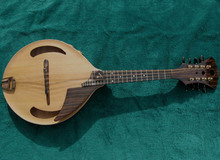 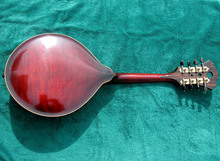
Click all pictures for closeup view
An avid mountain climber and all around adventurer, James observes, "Back in my days when someone would fall into a glacial crevasse on my rope team or when I'd flip a boat in a giant rapid on a river in some third world jungle, or even farther back when I was in uniform and people were shooting and trying to blast my jet out of the air, I'd get stressed some days. When someone doesn't like my mandolin, it's okay, probably not a good fit for them; not very high on the [personal] stress scale. I build them in all sorts of shapes and colors for folks, often times for some pretty stubborn folks (mandolin guys can be that way--I'm one of 'em) in ways that they insist upon because they know everything about it from reading that internet forum, yet I know it isn't my first choice." This is what we love most about his work, his respect and vast knowledge of traditional mandolin builds, yet fearlessness in taking these designs to their next challenging level.
Outside of the pickguard, there is no greater courageous aesthetic statement than his headstock. The inflated swagger and weight of extended wood is offset by the holes, again his tiny signature ascending trinity of broadening circles mirrored on the sideports. Add mass, subtract mass, and the builder successful creates an embellishing salutation that retains a physical endpin-to-headstock balance.
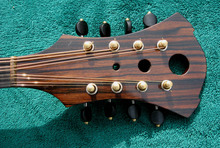 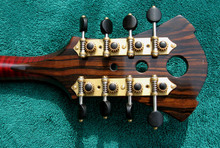
Here's where the purist (and potential customer) might get a little testy, the clash of seven-layer cake Macassar and ruddy German chocolate cake maple; an aesthetic combination not for the meek, but deliciously adventurous for the mandolinist not afraid to live on the aesthetic edge. (Works on a paper plate at a church potluck; why not here?)
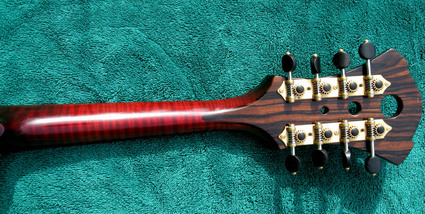
We confess a personal distaste for sideports in any mandolin. We feel it robs the instrument's ability to project the string fundamental, but the builder effectively arbitrates "the time tested reality for me is that they raise the fundamental of the box--just like when you enlarge the soundhole. That gives you more options for dynamic range and, in my opinion, is a bonus when ensemble playing, but also changes the voice. The port plugs allow you to tailor it to your preference and the 'tone of the week.' Like you mentioned, that instruments has a mix of ideas, but also has a very nice quality when you hit the right range."
As you'll observe from the pictures below, the instrument include three cork extended removable wood plugs to allow this kind of tonal variation, easily pinched into position. We pretty much kept them in the instrument all the time so as to project its awesome sound more forward.
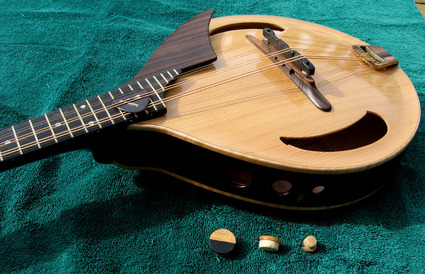
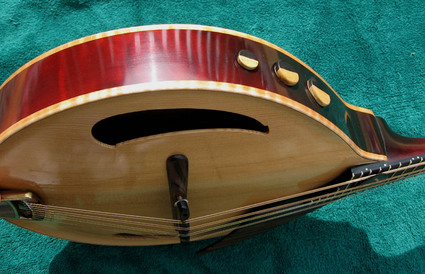
On a more experimental note, James included a sound hole cover. Interesting varying the tone with different combinations of closed sideports and top hole. With a little imagination, one could alter the instrument's timbre (no pun intended). After all, Miles Davis made a mark in jazz history with his the harmon mute in his trumpet fifty years ago. In this case, it might not be as effective, is the tone is not as radically different. In the hands of a creative player, though, who knows?
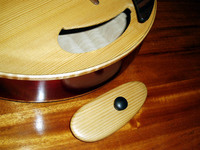 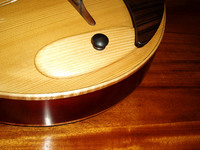
A top down closer view of the bridge reveals the three-hole aesthetic, as well. You also get a closer look at the generous graining in the top, an eyeful of marvelous tonewood.
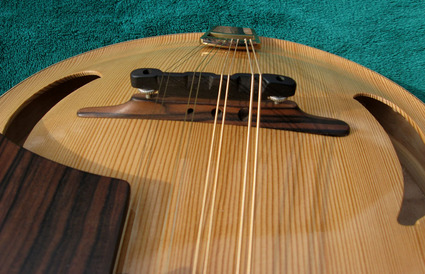
A better angle at the modified Orricos tailpiece; again, we are big fans of any kind of "quick change tailpiece, nothing to slide back in to place.

Click all pictures for closeup view
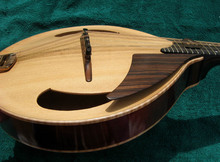 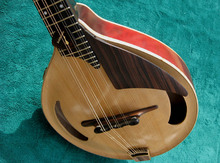
James considers this an "ensemble" instrument. We concur in that there is nothing harsh or in-your-face about its tone; it's very much a gets-along-with-others blending instrument. Still, we don't want to understate its amazing dynamic range. There's a huge variety of tone and volume packed in this astonishing instrument.
Builder's website: James Condino
Contact james@dreamguitars.com
Read past review: Condino Cricket and African Blackwood
Read Builder's article: The Mechanic's Corvette
Posted by Ted at February 27, 2010 5:37 AM

Disclaimer: In the 'Information Age' of the 21st Century,
any fool with a computer, a modem, and an idea can
become a self-professed 'expert." This site does not
come equipped with 'discernment.'
|



